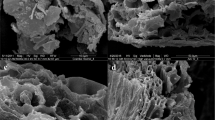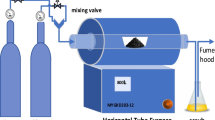Abstract
In this research, a novel green tillite-based adsorbent (CMT) was synthesized by modifying the surface of natural/pristine tillite (PT) with Chrysophyllum albidum stem bark extract for the efficient removal of Cr(VI) from water. The physicochemical characteristics of PT and CMT were assessed by the use of the FTIR, XRD, BET, TGA, and SEM techniques. Cardinal adsorptive parameters such as solution pH, contact time, adsorbent dose, and initial concentration were used to optimize the efficiency of PT and CMT for Cr(VI) adsorption. The Elovich kinetic model was noticed to best describe the uptake of Cr(VI) onto PT and CMT. Hence, chemisorption was the rate-controlling step for Cr(VI) uptake onto both PT and CMT. Meanwhile, the Langmuir maximum adsorption capacity of PT and CMT was 51.06 and 291.8 mg g−1 respectively, which was higher than those obtained for most materials used for Cr(VI) uptake. The Langmuir and Freundlich models best describe the equilibrium adsorption data for PT and CMT respectively. The reusability assessment of PT and CMT showed over 90% of the initial Cr(VI) uptake even after the fifth cycle of reuse. Electrostatic interaction and reduction of Cr(VI) were responsible for the removal of Cr(VI) from water onto the green material. The uptake of Cr(VI) was thermodynamically feasible, entropy-driven, and endothermic on both PT and CMT. The outcome of this study revealed that the anchoring of Chrysophyllum albidum stem bark extract on tillite produced a green adsorbent, which was highly efficient for the removal of Cr(VI) from polluted water.











Similar content being viewed by others
References
Sun H et al (2018) Structure-enhanced removal of Cr (vi) in aqueous solutions using MoS 2 ultrathin nanosheets. New J Chem 42(11):9006–9015
Pradhan SK, Panwar J, Gupta S (2017) Enhanced heavy metal removal using silver-yttrium oxide nanocomposites as novel adsorbent system. J Environ Chem Eng 5(6):5801–5814
Saha B, Orvig C (2010) Biosorbents for hexavalent chromium elimination from industrial and municipal effluents. Coord Chem Rev 254(23-24):2959–2972
Khan TA et al (2017) Removal of chromium (VI) from aqueous solution using guar gum–nano zinc oxide biocomposite adsorbent. Arab J Chem 10:S2388–S2398
Medeiros M et al (2003) Elevated levels of DNA–protein crosslinks and micronuclei in peripheral lymphocytes of tannery workers exposed to trivalent chromium. Mutagenesis 18(1):19–24
Das AK (2004) Micellar effect on the kinetics and mechanism of chromium(VI) oxidation of organic substrates. Coord Chem Rev 248(1):81–99
Mondal NK, Basu S (2019) Potentiality of waste human hair towards removal of chromium (VI) from solution: kinetic and equilibrium studies. Appl Water Sci 9(3):49
Baral A, Engelken RD (2002) Chromium-based regulations and greening in metal finishing industries in the USA. Environ Sci Pol 5(2):121–133
Pagilla KR, Canter LW (1999) Laboratory studies on remediation of chromium-contaminated soils. J Environ Eng 125(3):243–248
Kongsricharoern N, Polprasert C (1996) Chromium removal by a bipolar electro-chemical precipitation process. Water Sci Technol 34(9):109–116
Aksu Z et al (1996) Investigation of biosorption of chromium (VI) on Cladophora crispata in two-staged batch reactor. Environ Technol 17(2):215–220
Zwiener C, Frimmel F (2003) Short-term tests with a pilot sewage plant and biofilm reactors for the biological degradation of the pharmaceutical compounds clofibric acid, ibuprofen, and diclofenac. Sci Total Environ 309(1):201–211
Hartig C, Ernst M, Jekel M (2001) Membrane filtration of two sulphonamides in tertiary effluents and subsequent adsorption on activated carbon. Water Res 35(16):3998–4003
Heberer T (2002) Occurrence, fate, and removal of pharmaceutical residues in the aquatic environment: a review of recent research data. Toxicol Lett 131(1):5–17
Heberer T et al (2002) Production of drinking water from highly contaminated surface waters: removal of organic, inorganic, and microbial contaminants applying mobile membrane filtration units. CLEAN Soil Air Water 30(1):24–33. https://doi.org/10.1002/1521-401X(200207)30:1<24::AID-AHEH24>3.0.CO;2-O
Nghiem LD, Schäfer AI, Elimelech M (2005) Pharmaceutical retention mechanisms by nanofiltration membranes. Environ Sci Technol 39(19):7698–7705
Nghiem LD, Schäfer AI, Elimelech M (2004) Removal of natural hormones by nanofiltration membranes: measurement, modeling, and mechanisms. Environ Sci Technol 38(6):1888–1896
Tiravanti G, Petruzzelli D, Passino R (1997) Pretreatment of tannery wastewaters by an ion exchange process for Cr(III) removal and recovery. Water Sci Technol 36(2):197–207
Zhou X et al (1993) A process monitoring/controlling system for the treatment of wastewater containing chromium(VI). Water Res 27(6):1049–1054
Zwiener C, Frimmel F (2000) Oxidative treatment of pharmaceuticals in water. Water Res 34(6):1881–1885
Ternes TA et al (2002) Removal of pharmaceuticals during drinking water treatment. Environ Sci Technol 36(17):3855–3863
Ternes TA et al (2003) Ozonation: a tool for removal of pharmaceuticals, contrast media and musk fragrances from wastewater? Water Res 37(8):1976–1982
Huang S-D, Fann C-F, Hsieh H-S (1982) Foam separation of chromium(VI) from aqueous solution. J Colloid Interface Sci 89(2):504–513
Rani N, Singh B, Shimrah T (2017) Chromium (VI) removal from aqueous solutions using Eichhornia as an adsorbent. J Water Reuse Desalin 7(4):461–467. https://doi.org/10.2166/wrd.2016.094
Aslani H, Kosari TE, Naseri S, Nabizadeh R, Khazaei M (2018) Hexavalent chromium removal from aqueous solution using functionalized chitosan as a novel nano-adsorbent: modeling and optimization, kinetic, isotherm, and thermodynamic studies, and toxicity testing. Environ Sci Pollut Res 25(20):20154–20168. https://doi.org/10.1007/s11356-018-2023-1
Banerjee S et al (2018) Application of zirconium caged activated biochar alginate beads towards deionization of Cr (VI) laden water in a fixed bed column reactor. J Environ Chem Eng
Bibi I et al (2018) Chromium (VI) removal by siderite (FeCO 3) in anoxic aqueous solutions: an X-ray absorption spectroscopy investigation. Sci Total Environ 640:1424–1431
Chen Y-W et al (2018) Utilization of coal fly ash and drinking water sludge to remove anionic As (V), Cr (VI), Mo (VI) and Se (IV) from mine waters. J Environ Chem Eng 6(2):2470–2479
Fang W et al (2018) Synthesis of graphene/SiO2@ polypyrrole nanocomposites and their application for Cr (VI) removal in aqueous solution. Chemosphere 197:594–602
Neolaka YA, Supriyanto G, Kusuma HS (2018) Adsorption performance of Cr (VI)-imprinted poly (4-VP-co-MMA) supported on activated Indonesia (Ende-Flores) natural zeolite structure for Cr (VI) removal from aqueous solution. J Environ Chem Eng 6(2):3436–3443
Mikhaylov VI, Maslennikova TP, Krivoshapkina EF, Tropnikov EM, Krivoshapkin PV (2018) Express Al/Fe oxide–oxyhydroxide sorbent systems for Cr (VI) removal from aqueous solutions. Chem Eng J 350:344–355. https://doi.org/10.1016/j.cej.2018.05.023
Omer AM, Khalifa RE, Hu Z, Zhang H, Liu C, Ouyang XK (2019) Fabrication of tetraethylenepentamine functionalized alginate beads for adsorptive removal of Cr (VI) from aqueous solutions. Int J Biol Macromol 125:1221–1231. https://doi.org/10.1016/j.ijbiomac.2018.09.097
Ranjbar N et al (2018) Chromium (VI) removal by bone char–ZnO composite: parameters optimization by response surface methodology and modeling. Environ Prog Sustain Energy 37(5):1684–1695
Akpomie KG, Dawodu FA (2015) Montmorillonite-rice husk composite for heavy metal sequestration from binary aqua media: a novel adsorbent. Trans R Soc South Africa 70(1):83–88
Fenti A et al (2020) Cr (VI) sorption from aqueous solution: a review. Appl Sci 10(18):6477
Yang J, Huang B, Lin M (2020) Adsorption of hexavalent chromium from aqueous solution by a chitosan/bentonite composite: isotherm, kinetics, and thermodynamics studies. J Chem Eng Data 65(5):2751–2763
Dawodu FA, Akpan BM, Akpomie KG (2020) Sequestered capture and desorption of hexavalent chromium from solution and textile wastewater onto low cost Heinsia crinita seed coat biomass. Appl Water Sci 10(1):1–15
Akpomie KG, Conradie J (2020) Advances in application of cotton-based adsorbents for heavy metals trapping, surface modifications and future perspectives. Ecotoxicol Environ Saf 201:110825
Chukwuemeka-Okorie HO et al (2018) Calcined corncob-kaolinite combo as new sorbent for sequestration of toxic metal ions from polluted aqua media and desorption. Front Chem 6:273
Sing KS (1985) Reporting physisorption data for gas/solid systems with special reference to the determination of surface area and porosity (Recommendations 1984). Pure Appl Chem 57(4):603–619
Brunauer S, Emmett P (1940) Chemisorptions of gases on iron synthetic ammonia catalysts1. J Am Chem Soc 62(7):1732–1746
Akpomie KG, Conradie J (2020) Banana peel as a biosorbent for the decontamination of water pollutants. A review. Environ Chem Lett 18(4):1085–1112. https://doi.org/10.1007/s10311-020-00995-x
Jin X et al (2018) Removal of Cr (VI) from aqueous solutions via reduction and absorption by green synthesized iron nanoparticles. J Clean Prod 176:929–936
Huang Y et al (2018) Fast and efficient removal of chromium (VI) anionic species by a reusable chitosan-modified multi-walled carbon nanotube composite. Chem Eng J 339:259–267
Wu F-C, Tseng R-L, Juang R-S (2009) Characteristics of Elovich equation used for the analysis of adsorption kinetics in dye-chitosan systems. Chem Eng J 150(2-3):366–373
Zang Y et al (2018) Research on adsorption of Cr (VI) by poly-epichlorohydrin-dimethylamine (EPIDMA) modified weakly basic anion exchange resin D301. Ecotoxicol Environ Saf 161:467–473
Labied R et al (2018) Adsorption of hexavalent chromium by activated carbon obtained from a waste lignocellulosic material (Ziziphus jujuba cores): kinetic, equilibrium, and thermodynamic study. Adsorpt Sci Technol 36(3-4):1066–1099
Ogbu I, Akpomie K, Osunkunle A, Eze S (2019) Sawdust-kaolinite composite as efficient sorbent for heavy metal ions. Bangladesh J Sci Ind Res 54(1):99–110. https://doi.org/10.3329/bjsir.v54i1.40736
Langmuir I (1933) Surface chemistry. Chem Rev 13(2):147–191
Choy KK, Porter JF, McKay G (2000) Langmuir isotherm models applied to the multicomponent sorption of acid dyes from effluent onto activated carbon. J Chem Eng Data 45(4):575–584
Rao M, Parwate A, Bhole A (2002) Removal of Cr6+ and Ni2+ from aqueous solution using bagasse and fly ash. Waste Manag 22(7):821–830
Li Y et al (2008) Adsorption thermodynamic and kinetic studies of dissolved chromium onto humic acids. Colloids Surf B: Biointerfaces 65(1):25–29
Altundogan HS (2005) Cr(VI) removal from aqueous solution by iron (III) hydroxide-loaded sugar beet pulp. Process Biochem 40(3):1443–1452
Ma M et al (2014) Hexavalent chromium removal from water using heat-acid activated red mud. Open J Appl Sci 4(05):275
Baral SS et al (2007) Chromium (VI) removal by calcined bauxite. Biochem Eng J 34(1):69–75
Bhattacharya A et al (2008) Adsorption, kinetics and equilibrium studies on removal of Cr (VI) from aqueous solutions using different low-cost adsorbents. Chem Eng J 137(3):529–541
Hu J et al (2009) Removal of chromium from aqueous solution by using oxidized multiwalled carbon nanotubes. J Hazard Mater 162(2):1542–1550
Mi X et al (2012) Preparation of graphene oxide aerogel and its adsorption for Cu2+ ions. Carbon 50(13):4856–4864
Chagas PMB et al (2018) Nanostructured oxide stabilized by chitosan: hybrid composite as an adsorbent for the removal of chromium (VI). J Environ Chem Eng 6(1):1008–1019
Qiu J et al (2009) Adsorption of Cr (VI) using silica-based adsorbent prepared by radiation-induced grafting. J Hazard Mater 166(1):270–276
Zambrano-Intriago LA, Gorozabel-Mendoza ML, Córdova Mosquera A et al (2020) Kinetics, equilibrium, and thermodynamics of the blue 19 dye adsorption process using residual biomass attained from rice cultivation. Biomass Conv Bioref. https://doi.org/10.1007/s13399-020-00944-2
Eze SI, Akpomie KG, Ezekoye OM, Chukwujindu CN, Ojo FK, Ani JU, Ujam OT (2021) Antibiotic adsorption by acid enhanced Dialium guineense seed waste. Arab J Sci Eng 46(1):309–324. https://doi.org/10.1007/s13369-020-04771-5
Liang X et al (2018) Efficient removal of Cr (VI) from water by quaternized chitin/branched polyethylenimine biosorbent with hierarchical pore structure. Bioresour Technol 250:178–184
Dawodu FA, Akpomie KG (2014) Simultaneous adsorption of Ni (II) and Mn (II) ions from aqueous solution unto a Nigerian kaolinite clay. J Mater Res Technol 3(2):129–141
Nessim RB et al (2011) Biosorption of lead and cadmium using marine algae. Chem Ecol 27(6):579–594
Wang J et al (2018) Polyvinylpyrrolidone and polyacrylamide intercalated molybdenum disulfide as adsorbents for enhanced removal of chromium (VI) from aqueous solutions. Chem Eng J 334:569–578
Samuel MS et al (2018) Preparation of graphene oxide/chitosan/ferrite nanocomposite for Chromium (VI) removal from aqueous solution. Int J Biol Macromol 119:540–547
Mystrioti C et al (2016) Comparative evaluation of five plant extracts and juices for nanoiron synthesis and application for hexavalent chromium reduction. Sci Total Environ 539:105–113
Funding
The authors gratefully acknowledge the financial support from TETFund National Research Fund grant (TETF/DR&D/CE/NRF/STI/66/Vol.I).
Author information
Authors and Affiliations
Corresponding author
Ethics declarations
Conflict of interest
The authors declare no competing interests.
Additional information
Publisher’s note
Springer Nature remains neutral with regard to jurisdictional claims in published maps and institutional affiliations.
Supplementary Information
ESM 1
(DOCX 36 kb).
Rights and permissions
About this article
Cite this article
Amaku, J.F., Nnaji, J.C., Ogundare, S.A. et al. Chrysophyllum albidum stem bark extract coated tillite adsorbent for the uptake of Cr(VI): thermodynamic, kinetic, isotherm, and reusability. Biomass Conv. Bioref. 13, 4865–4877 (2023). https://doi.org/10.1007/s13399-021-01489-8
Received:
Revised:
Accepted:
Published:
Issue Date:
DOI: https://doi.org/10.1007/s13399-021-01489-8




